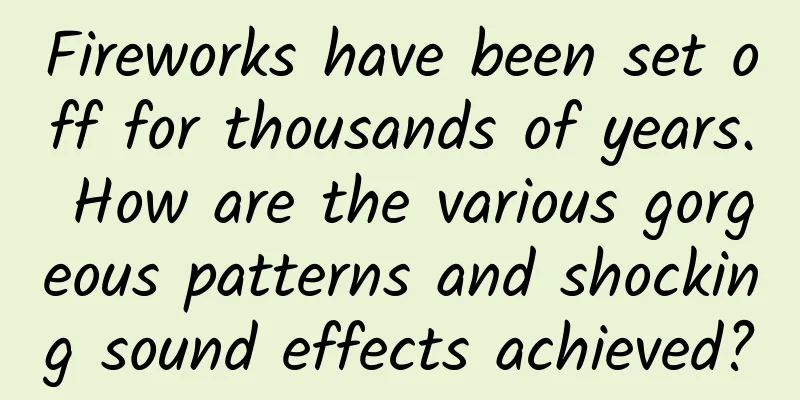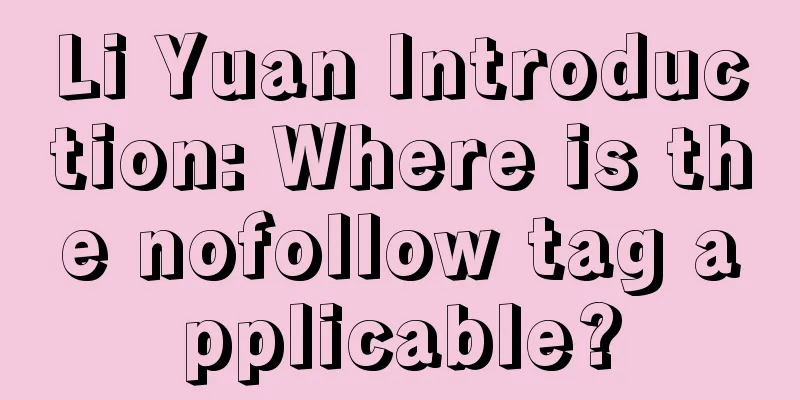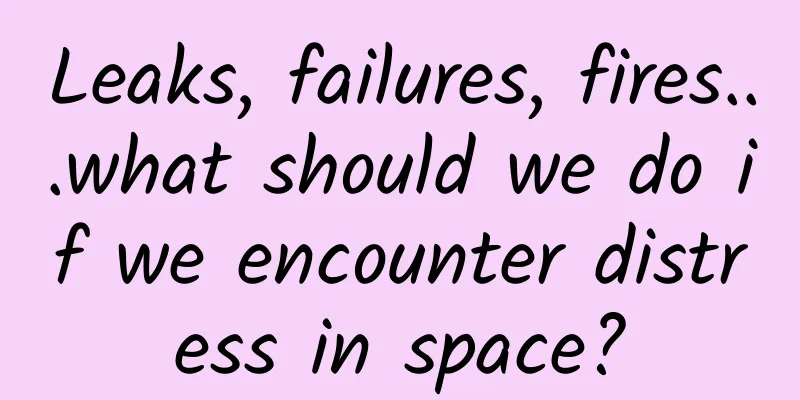Fireworks have been set off for thousands of years. How are the various gorgeous patterns and shocking sound effects achieved?

|
Produced by: Science Popularization China Author: Li Zhen (Changchun Institute of Optics, Fine Mechanics and Physics, Chinese Academy of Sciences) Producer: China Science Expo Fireworks have a long history in my country. The ancients used vivid verses such as "The east wind blows thousands of flowers in the night, and blows them down like rain of stars" to describe the splendor of fireworks. Nowadays, people also set off fireworks to celebrate large events or important festivals. Every time a firework is set off, it is a double feast of vision and emotion. People watching fireworks (Photo source: Veer Gallery) In fact, these gorgeous patterns and ever-changing sound effects are all designed in advance and realized through technology! Today, let's take a look at the scientific knowledge behind fireworks design. Fireworks first appeared in my country in the Tang Dynasty! The history of fireworks can be traced back to the Tang Dynasty in the 9th century AD, when fireworks were used to drive away evil spirits and pray for good luck. In the Song Dynasty, the use of fireworks gradually shifted to festivals and entertainment, and the technology of making fireworks began to develop. The form of fireworks was not limited to simple firecrackers, and fireworks with various shapes and rich colors began to appear. In the Ming and Qing Dynasties, the production skills of fireworks continued to improve, and gradually became an important part of the celebrations of the royal family and the nobility, and were also widely used in festivals and celebrations, such as the Spring Festival and the Lantern Festival. As fireworks technology continues to develop, it has gradually spread to all parts of the world and has become a highlight of global festivals and celebrations. From traditional Chinese celebrations, fireworks have moved to the world stage and become a wonderful art that combines historical culture with modern technology. Bohemian artist Wenceslaus Hollar's print "Fireworks at Hermiseum" (Date of creation: circa 1625-77) (Image credit: Metropolitan Museum of Art) How do modern fireworks bloom into various shapes? Modern fireworks can accurately create a variety of beautiful shapes when they bloom. These shapes are produced by precisely calculating and designing the charge and arrangement of stars in the fireworks. Stars are small particles composed of various metal salts, oxidants, gunpowder, etc., which determine the shape and color of the fireworks when they bloom. The production of each star requires a precise chemical ratio to ensure that it achieves the desired effect when it explodes. Therefore, stars are not only the source of the gorgeous performance of fireworks, but also the essence of the art of fireworks. When the fireworks are launched, the thrust generated by the explosion of gunpowder can push the stars to the pre-designed direction, allowing the stars to diverge in all directions, thus showing a variety of beautiful patterns in the air. For example, by precisely arranging the gunpowder bags and setting the delay fuses, the fireworks can explode in mid-air and form fantastic patterns such as stars and flowers, as if drawing a beautiful picture in the night sky. Three ways to lay out fireworks (Image source: Wikipedia) Some fireworks use gunpowder as a drive, which can rotate in the air like dancing stars, bringing a dynamic visual experience. Fireworks streak across the night sky like shooting stars and light up the entire night sky in an instant. The shape design and ignition timing of fireworks are like a brush in the hands of an artist, sketching out moving pictures of the night sky. The internal arrangement of fireworks (Image source: Wikipedia) How are all the brilliant colors achieved? Fireworks have been loved since ancient times for their brilliant colors. These colors are not generated randomly, but come from a physical phenomenon called flame color reaction . Whenever brilliant colors bloom in the night sky, it is the result of metal atoms dancing in the flames. Specifically, when different metal elements are heated in the flames, the electrons in the metal atoms absorb the heat and jump to a higher energy level like jumping elves. When the temperature drops, the electrons jump from the high energy level to the low energy level and release energy, which is manifested in the form of light of different wavelengths. Different wavelengths of light correspond to different colors in our eyes, and the colors of fireworks are produced through this reaction. Flame color reactions of common metals (Photo source: Science Hut) In order to produce fireworks of different colors, fireworks designers will add different metals or metal salts to the fireworks, such as adding potassium salts to produce purple, adding sodium salts to produce yellow, etc. Some special fireworks will also control the order of burning gunpowder and the spatial position of metal salts, so as to present fireworks with different colors or gradient colors that change over time. At the same time, fireworks designers also need to adjust the formula of gunpowder to control the temperature and burning rate. The higher the temperature, the more intense the excitation of metal elements and the brighter the color; the oxidant and fuel components in the gunpowder will also affect the presentation of the flame color. Therefore, the color of fireworks is not a simple physical phenomenon, but an artistic crystallization of the precise blending of physics and chemistry. Beautiful colorful colors after fireworks explosion (Photo source: veer photo gallery) Can you also design the high or low sound effects when fireworks explode? Nowadays, fireworks displays are no longer limited to visual effects, but sound has become an important part of the art of fireworks. In large-scale festivals and fireworks displays, sound and vision are often synchronized to create a stunning visual and auditory experience. The sound of fireworks is mainly produced by the explosion of gunpowder. Gunpowder releases a large amount of gas when it explodes, and these gases expand violently at the moment of explosion, generating pressure waves that propagate outward. Just like a huge drop of water falling into the lake, the waves aroused quickly spread in all directions. The "boom" sound we hear is the result of the sudden and drastic change in air pressure. Modern fireworks can control the pitch by adjusting the ratio of metal salts and other chemical components in gunpowder to change the speed and pressure of gas expansion during the explosion. Using different metal salts (such as aluminum, barium or zirconium) is like adding different tones to a note, which can affect the rate of combustion reaction and the way the gas expands, adjusting the frequency of the explosion to make it high-pitched or deep. The shell design of fireworks also plays a key role in the sound effect. The shell of modern fireworks is usually made of materials such as paper shell, aluminum foil or metal foil. Different designs can affect the transmission and sound quality of the sound. For example, a hard shell (such as a steel shell) can cause a stronger explosion sound, like thunder, while a soft shell (such as a paper shell) will make the explosion sound duller and lower. Modern fireworks are not just simple explosions and blooms, but contain profound scientific principles and sophisticated design art. Every fireworks show is a perfect combination of chemistry, physics and art. By understanding the scientific principles behind these, we can not only appreciate the beauty of fireworks more, but also feel the infinite possibilities brought by science and technology. In the future fireworks shows, there will be a more splendid and stunning audio-visual feast. |
Recommend
Feed ads not working well? Here are a few hidden optimization tips!
Before starting this article, let’s take a look a...
What is server hosting?
What is server hosting? In general, server rental...
It is difficult to root Android 4.4.3/4.5
In January this year, Chainfire, a well-known deve...
The war between Chinese internet companies spreads to Southeast Asia: The big battle is imminent
More and more Chinese Internet companies are begi...
These strange "pretenders" around us are actually very useful
The weather is getting cooler, and it is a good t...
The new iPadOS 13.1 is released with many powerful new features
Apple today released iPadOS 13.1, a powerful, new...
National Bureau of Statistics: Energy production in May 2021
In May , industrial raw coal production above des...
Attention! WeChat often pops up this type of ads, which means you are being "monitored". Please close it as soon as possible
The ads placed by WeChat have made many users pon...
Musk and SoftBank discussed SoftBank's investment in Tesla. SoftBank: The valuation is too high
According to people familiar with the matter, Mus...
National New Energy Vehicle Project Team: Four points to understand the energy consumption of electric vehicles per 100 kilometers is the key to getting points
Statistics show that China consumed 556 million t...
In the wars of unification of ancient Chinese dynasties, why was Zhu Yuanzhang the only one who could unify China from south to north?
Although great unification was the mainstream and...
What should I do if there are too many credit inquiry records? This is how it is handled
How to deal with too many credit inquiry records?...
The Losers Behind the 2016 Car Market
This year's auto market can be described as &...
iPhone X will be criticized, but it will still be popular | On 4P and brand
The iPhone is criticized every year, so why does ...









